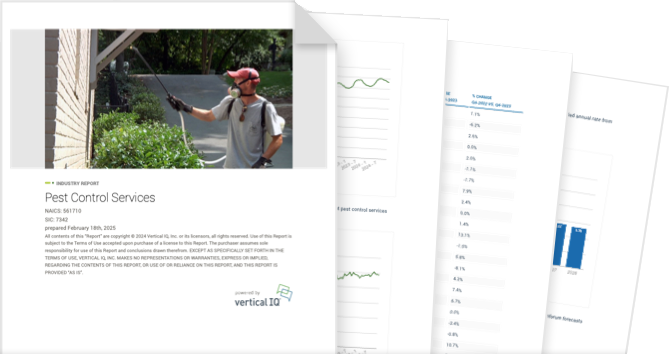Perishable Prepared Food Manufacturers NAICS 311991

Unlock access to the full platform with more than 900 industry reports and local economic insights.
Get access to this Industry Profile including 18+ chapters and more than 50 pages of industry research.
Industry Summary
The 852 perishable prepared food manufacturers in the US produce fresh, ready-to-eat or ready-to-heat food that provide convenience for consumers. Products include pastas and noodles, processed fruits and vegetables, salads and slaws, pizzas, sandwiches and wraps, tofu, hard-boiled eggs, refrigerated snack packs, cooked meats, refrigerated soups and stews, meat pies and quiches, and packaged lunches.
Competition for Retail Shelf Space
Firms can lose access to markets if products are slow movers or expire on retailers’ shelves, as competition for shelf space is fierce, especially for refrigerated foods.
Healthier Prepared Options
Consumers are looking for convenient prepared food options that are healthier than fast food.
Recent Developments
Nov 30, 2025 - Trump Exempts 200-Plus Foods From Tariffs
- President Trump has issued an executive order eliminating reciprocal tariffs on hundreds of food products, including coffee, tea, bananas, oranges, tomatoes, beef, tropical fruits, fruit juices, and more, Grocery Dive reported in November. In all, more than 200 agricultural commodities are now exempt from the 10% global tariff and country-specific duties imposed by the Trump administration earlier this year. The White House said the exemptions result from the administration’s progress on various trade deals, including with countries that produce agricultural goods not commonly grown in the US. Trump’s move comes amid lingering grocery inflation and growing consumer frustration with the high cost of living. The tariff rollback lowers costs and supply constraints for importers, which should travel through the supply chain to food manufacturers, retailers, and ultimately consumers.
- New research from consumer insights firm Circana finds that households using GLP-1 medications for weight‑loss or diabetes are projected to account for 35% of all US food and beverage units sold by 2030, up from about 23% at present. Because GLP‑1 users are increasingly focused on weight management, their shopping patterns are shifting dramatically. They’re buying fewer carb- and sugar-heavy foods, while favoring higher‑protein, high‑fiber, and healthy‑fat foods. Even though their total retail food spending dips, they still outspend non-users overall. For food manufacturers, especially those reliant on sugary, high‑carb meals, this trend signals reduced demand. To stay relevant, companies will likely need to reformulate or expand into products aligned with health‑centered, high‑protein, low‑sugar diets and adjust their marketing to appeal to this growing group of shoppers.
- While some food companies are breaking up amid challenging market conditions (notably Kraft Heinz), others are on the hunt for deals, The Wall Street Journal reports citing fresh deli prepared foods manufacturer Mama’s Creations acquisition of Crown I Enterprises in September. Mama’s Creations, which supplies major retailers like Costco and Walmart, purchased the ready-to-eat meal maker from food service distributor Sysco for $17.5 million. The acquisition brings the potential for more customers, the ability to make meatballs and other items faster and at a lower cost, and adds a 42,000-square-foot manufacturing facility, according to WSJ. With rising menu prices having many consumers saving money by eating prepared foods at home, deli department sales are growing faster than other grocery departments, according to consumer market research firm Circana. Mama’s expansion while other companies retrench shows growth can still be on the table in a difficult market.
- Producer prices for perishable prepared food manufacturers fell 0.9% in August compared to a year ago, after rising 2.8% in the previous August-versus-August annual comparison, according to the latest US Bureau of Labor Statistics data. At retail, by comparison, the price of frozen and freeze dried prepared foods rose 0.4% year over year in August but was down 1.9% versus July, while the retail price of prepared salads rose 3.8% YoY in August and 0.4% versus July, according to the August 2025 Consumer Price Index report. Employment by the industry was flat year over year in July, while the average industry wage at food manufacturers rose 2% YoY in August to $23.98 per hour, easing from its high in January, BLS data show.
Industry Revenue
Perishable Prepared Food Manufacturers

Industry Structure
Industry size & Structure
The average perishable prepared food manufacturer operates out of a single location, employs about 87 workers, and generates about $30.4 million annually.
- The perishable prepared food manufacturing industry consists of about 852 companies, which employ about 74,300 workers and generate about $25.9 billion annually.
- The industry is concentrated with the 20 largest firms representing 59% of industry revenue.
- Customer industries include food distributors, grocers, convenience stores, institutions, airports, and vending machine owners.
- Large companies include Fresh Express, Fresh & Ready Foods, E.A. Sween Company, Reser’s Fine Foods, and Spring Glen, as well as divisions of large food manufacturers such as Kraft Heinz (Lunchables).
Industry Forecast
Industry Forecast
Perishable Prepared Food Manufacturers Industry Growth

Vertical IQ Industry Report
For anyone actively digging deeper into a specific industry.
50+ pages of timely industry insights
18+ chapters
PDF delivered to your inbox
